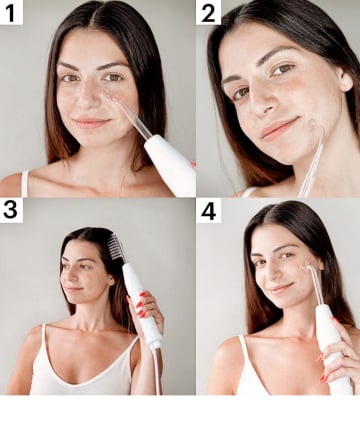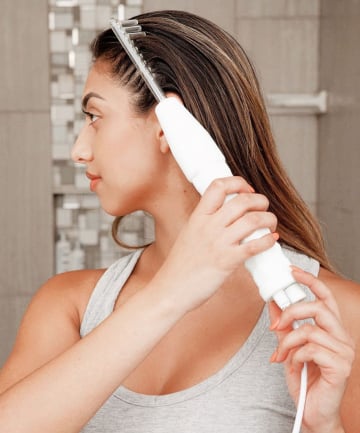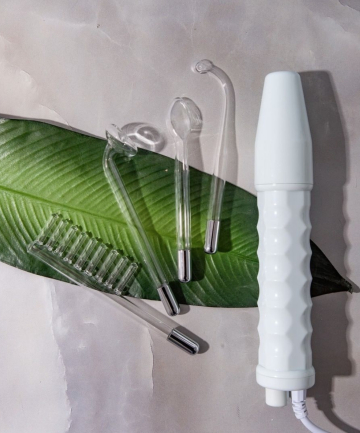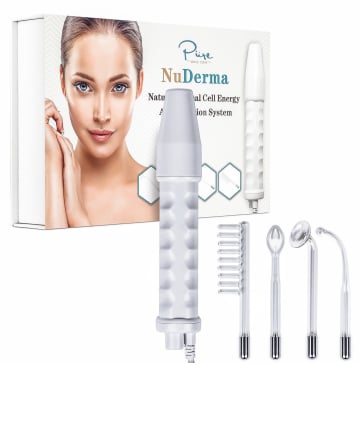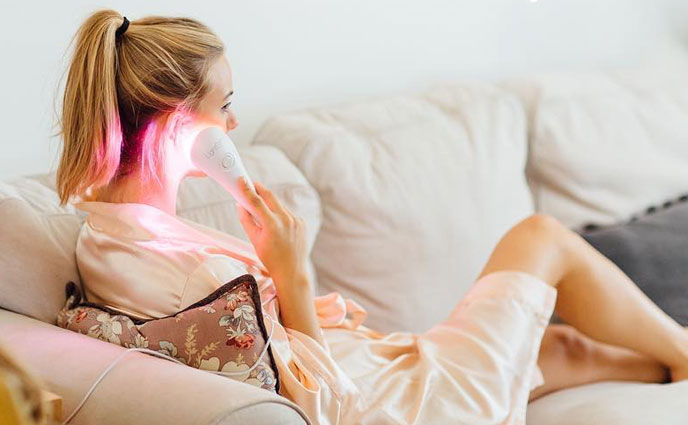So, what is this machine that promises to make your skin look its best? High-frequency machines are used by professionals (or at-home if you'd like to invest into learning how to use it on your own) to treat and prevent angry pimples, shrink large pores, reduce darkness and puffiness under the eyes, and even to rejuvenate the scalp for healthier hair growth. It also helps products to penetrate deeper into the skin, since it gently warms the skin tissue.
Image via @puredailycare
Image via @puredailycare
The machine gently oscillates and uses a high-frequency electrical current to eliminate the toxins that cause acne. Each machine uses different electrodes, which are tempered glass pieces that connect to the machine and are applied to the skin to radiate the high-frequency. There are different electrodes for different uses: one that's mushroom-shaped for treating then entire face, a small, pointed tip for detailed work, and even one that looks like a comb to be applied through your hair and on the scalp.
Once you've chosen your desired electrode, it's best to use the high-frequency machine on a lower setting on the skin before immediately going to your face. It can be used on multiple different levels. Most are comfortable, depending on your tolerance. Don't worry, though: While high-frequency machines sound potentially scary and painful, they don't actually hurt. (They do provide a sensation, but nothing that should be uncomfortable.)
After setting up your electrodes, you'll want to hold the device in hand, turn on the machine to your desired setting, and then apply your finger to the electrode. Then, bring the machine to your face (you can apply it directly to bare skin or use a thin tissue or fabric between your skin and the machine if you're a bit more sensitive). Once the electrode is touching your complexion, you can remove your finger. This will make sure your skin doesn't experience a pesky zapping sensation as it's applied to the skin.
After you've gotten the electrode to comfortably touch the face, you can proceed to move around the high-frequency machine around your skin. You'll want to make sure you're constantly moving the machine around and not keeping it stagnant in one spot for any period of time. It should be used for no longer than 5 minutes per session, and most estheticians recommend using it once, maybe twice, per week.
Image via @puredailycare
Once you've chosen your desired electrode, it's best to use the high-frequency machine on a lower setting on the skin before immediately going to your face. It can be used on multiple different levels. Most are comfortable, depending on your tolerance. Don't worry, though: While high-frequency machines sound potentially scary and painful, they don't actually hurt. (They do provide a sensation, but nothing that should be uncomfortable.)
After setting up your electrodes, you'll want to hold the device in hand, turn on the machine to your desired setting, and then apply your finger to the electrode. Then, bring the machine to your face (you can apply it directly to bare skin or use a thin tissue or fabric between your skin and the machine if you're a bit more sensitive). Once the electrode is touching your complexion, you can remove your finger. This will make sure your skin doesn't experience a pesky zapping sensation as it's applied to the skin.
After you've gotten the electrode to comfortably touch the face, you can proceed to move around the high-frequency machine around your skin. You'll want to make sure you're constantly moving the machine around and not keeping it stagnant in one spot for any period of time. It should be used for no longer than 5 minutes per session, and most estheticians recommend using it once, maybe twice, per week.
Image via @puredailycare
If you're experiencing a breakout that is unusually deep under the surface, you can also choose to "zap" it. Again, this may sound scary, but it's quite bearable. You'll want to tap the machine onto the specific area of the pimple then remove, apply then remove, and so on. You can do this about 5-10 times then you'll want to stop so you don't make the breakout inflamed or more irritated than it already may be pre-high-frequency.
Overall, it's easy to add in this extra step to your routine to make sure that your breakouts are staying far, far away. It is best to consult with your doctor or dermatologist before starting high-frequency treatments whether they be done at home or in a spa.
Image via @puredailycare
Overall, it's easy to add in this extra step to your routine to make sure that your breakouts are staying far, far away. It is best to consult with your doctor or dermatologist before starting high-frequency treatments whether they be done at home or in a spa.
Image via @puredailycare


